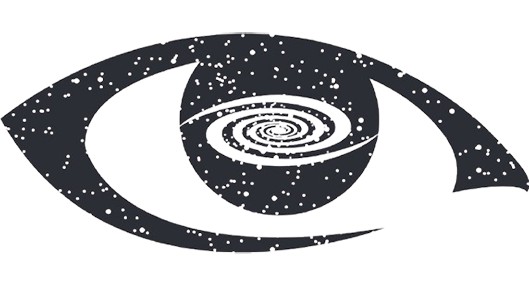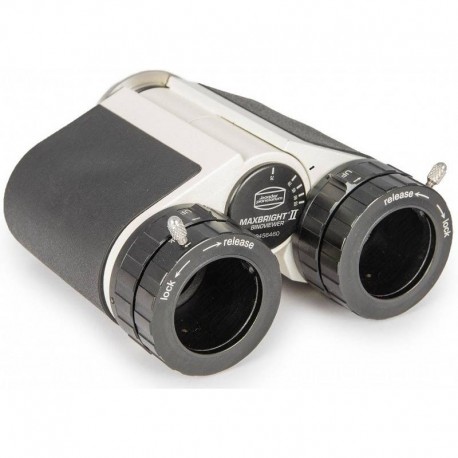No products
Prices are tax included
Baader MaxBright II Binoviewer complete with case (2456460S)
Baader MaxBright II Binoviewer
New product
Baader MaxBright II Binoviewer with case
According to availability at the supplier. Please contact us for more information
More info
Baader MaxBright II Binoviewer with case
Baader MaxBright® II Binoviewer
"Supercharged" by design
The MaxBright® II Binoviewer incorporates the knowledge aquired during thirty years of building astronomical binoviewers. It is superior to cheaper models in many details.

- The housing of the 27mm large prisms is made with our own die casting moulds, using Carl Zeiss production drawings. The non-slip leather finish provides extra grip when holding the binoviewer with heavy eyepieces in your hand.
- On the eyepiece side, the newly designed, self-centering Clicklock® eyepiece clamps with diopter adjustment are immediately noticeable. Thanks to the ergonomic design, you can blindly distinguish between clamping and diopter compensation even in the dark. The inner parts are made of stainless steel for maximum stability. The high-quality eyepiece clamps are only the last part of the precisely collimated optical system, which is designed for highest magnifications. This is the only way to achieve the almost three-dimensional image and relaxed observation expected from a binoviewer.
- All optical surfaces of the Maxbright® II feature a 7-layer multi-coating. The prism chairs (mounts) of the prisms are constructed like those of the Mark V Großfeld (Giant)-Binocular (#2456410, € 1425,-) . The clear aperture is 26 mm on the telescope side and 25,5mm on the eyepiece side – even our 35 mm eudiascopic eyepieces are illuminated without vignetting. In comparison to models with smaller prisms you can see a much larger part of the sky at the same magnification – similar to our Mark V Großfeld (Giant)-Binocular (#2456410, € 1425,-) .
- On the telescope side, either a T-2 cap nut or a dovetail ring with original Zeiss micro bayonet are available – both connection options are included in the scope of delivery and allow a very compact adaptation to all common threads as well as our T-2 prisms and mirrors. Compared to fixed nosepieces, this effectively saves a lot of backfocus. The MaxBright® II is compatible with all Baader Glasspathcorrectors. According to optical calculations by Carl Zeiss, these correction lens systems shift the focus outwards so that you can still reach focus despite the approximately 11 cm back focus (the required inward travel of the focuser) of the binoviewer. They also compensate for the colour error that would otherwise be introduced through the prisms when using telescopes between f/4 and f/7. Glasspathcorrectors are not simple Barlow lenses, even if they resemble them. For this reason, in Germany the name Glaswegkorrektor® is a protected trademark by Baader Planetarium.
In combination with a lens telescope or a Schmidt-Cassegrain we recommend the Baader T-2 Stardiagonal (Zeiss) Prism with BBHS ® coating (T-2 part #01B) (#2456095, € 243,-) or the Baader FlipMirror II Star Diagonal (#2458055, € 228,-) , to achieve a compact telescope adaptation. In addition, you can then choose a matching Glasspathcorrector
To select the right Glasspathcorrector, you need to know the backfocus of your telescope. You can read how to do this in the Manual of the Maxbright® II Binoviewer.
For Newtonians,we recommend either the large 2" Glasspathcorrector® 1,7x for Newtons (#2456300, € 205,-) or the Glasspathcorrector 1:2,60 for Baader-Binoviewer with Zeiss ring dovetail (MaxBright® II and Mark V) (#2456317, € 132,-) .
For SCs or lens telescopes we recommend either the 2" Glasspathcorrector® 1,8x for Refractors and SC's (#2456305, € 195,-) or the two T-2 Glasspathcorrectors Glasspathcorrector 1:1,25 for Baader-Binoviewer with T-2 thread (MaxBright® II and MaxBright®) (#2456314, € 122,-) and Glasspathcorrector 1:1,70 for Baader-Binoviewer with T-2 thread (MaxBright II® and MaxBright®) (#2456316, € 127,-) . The 1.25x Glasspathcorrector is used on lens telescopes mainly for removing the colour aberrations, which would otherwise be introduced by the long light path through the prisms of the binoviewer.
You don't necessarily need a Glasspathcorrector for Schmidt-Cassegrains with f/10. Especially for lower magnifications and thus larger fields vof view, the Alan Gee Telecompressor Mark II (T-2 part #20) (#2454400, € 275,-) is more interesting: It shortens the focal ratio to ca. f/5,9, which gives you a brighter image and a larger field of view. So, a C8 almost becomes a rich-field telescope – for comfortable observations with both eyes open!
Binoviewers and accessories
Baader Planetarium has more than 30 years of experience in building binoviewers. Therefore we do not offer simple modified microscope binoviewers without further accessories, but complete system solutions.
With monocular vision, your brain can only use a fraction of its "computing capacity". In fact, there is a kind of "emergency mode" in the brain so that even image information obtained with one eye can be distributed to both halves of the brain, but the brain has no way of correctly interpreting the "image errors" and above all the "nerve noise" that inevitably occurs during energy transport - just like with a CCD image!
Just as the user of a CCD camera or webcam superimposes several images in the computer, i.e. "stacks" images, the brain can also superimpose the different information from both eyes during binocular vision and in this way - each time in milliseconds - eliminate the imperfections that are not part of the real image.
So it is no wonder that after observing with one eye for a few minutes, you will have to take a rest that your brain demands because it is simply overloaded by the extremely concentrated viewing. In binocular vision, this problem does not exist! You can look as long as you want and remain relaxed. Even with severely impaired vision in one eye, the reduced tension results in an enormous gain in observation quality.
One often hears the criticism that using a binoviewer would split the light into two visual channels and that only 50% of the light intensity reaches each eye. This argument prevents many people from trying out for themselves what a revolutionary effect binocular vision has. But what is forgotten is that 50% of the light reaches each eye and that the energy from both eyes is "reunited in the brain" (more precisely, in the back of the head).
What you then see is by no means 50% darker than it is claimed. The real gain is only visible for someone who has tried it out for himself and has familiarized himself with this kind of seeing for a few minutes. Ultimately, the object doesn't look darker, but becomes visible effortless, more detailed and - more beautiful.
| General | |
|---|---|
| Manufacturer | Baader Planetarium |
| SKU (#) | 2456460 |
| EAN Code | 4047825042873 |
| Net weight (kg) | 0,595 |
| Specifications | |
| Aperture (mm) | Teleskopseitig 26 mm, Okularseitig 25,5 mm |
| Prisms | 27 mm |
| Lens Coatings | 7-lagig Mehrschicht-entspiegelt |
| Prism Coatings | 7-lagig Mehrschicht-entspiegelt |
| Included Accessories |
ABS hard plastic case, T-2 thread adapter, Zeiss ring dovetail |











